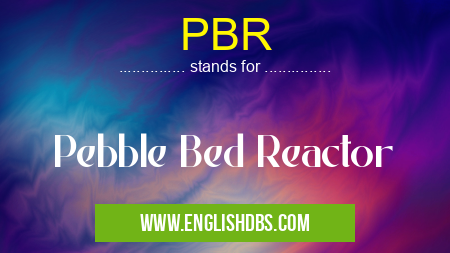What does PBR mean in UNCLASSIFIED
PBR stands for Pebble Bed Reactor, a type of nuclear reactor that utilizes small, spherical fuel elements known as pebbles. These pebbles contain fissile material and moderator, enabling them to sustain a controlled nuclear chain reaction. PBRs offer several unique advantages over traditional nuclear reactors, making them an important consideration in the development of advanced nuclear energy systems.

PBR meaning in Unclassified in Miscellaneous
PBR mostly used in an acronym Unclassified in Category Miscellaneous that means Pebble Bed Reactor
Shorthand: PBR,
Full Form: Pebble Bed Reactor
For more information of "Pebble Bed Reactor", see the section below.
Key Features of PBRs
- Pebble Fuel: PBRs utilize spherical fuel elements that resemble pebbles, ranging in diameter from a few centimeters to several centimeters. These pebbles consist of a fissile material, such as uranium or thorium, embedded in a moderator material, typically graphite.
- High-Temperature Operation: PBRs operate at significantly higher temperatures compared to conventional nuclear reactors, typically in the range of 900-1000 degrees Celsius. This high-temperature operation allows for efficient heat transfer and the potential for cogeneration of electricity and heat.
- Passive Safety Features: PBRs incorporate inherent safety features that reduce the risk of severe accidents. The spherical fuel geometry promotes natural circulation of the coolant, eliminating the need for active cooling systems. The use of graphite as a moderator further enhances safety by acting as a neutron absorber, providing a passive shutdown mechanism.
Advantages of PBRs
- Improved Fuel Utilization: The pebble fuel design allows for continuous refueling without the need for reactor shutdown, maximizing fuel utilization and reducing waste generation.
- High Thermal Efficiency: The high operating temperature of PBRs enables efficient heat transfer, resulting in higher thermal efficiency and electricity production.
- Enhanced Safety: The inherent safety features of PBRs minimize the risk of accidents and reduce the need for complex safety systems.
- Cogeneration Potential: The high-temperature operation of PBRs allows for the cogeneration of electricity and heat, providing additional economic benefits.
Essential Questions and Answers on Pebble Bed Reactor in "MISCELLANEOUS»UNFILED"
What is a Pebble Bed Reactor (PBR)?
A PBR is a type of advanced nuclear reactor that uses small, spherical fuel elements known as pebbles. These pebbles are typically made of graphite or ceramic coated with nuclear fuel, such as uranium or thorium. The pebbles are loaded into the reactor core and circulated through a coolant, usually helium gas. As the pebbles circulate, they are heated by the nuclear reactions taking place within them. The heat is then transferred to the coolant, which is used to generate electricity.
What are the advantages of PBRs?
PBRs offer several advantages over traditional nuclear reactors. They are inherently safe because the pebbles are small and can be easily cooled in the event of an accident. They are also very efficient because the pebbles can be circulated continuously, ensuring a constant supply of fresh fuel to the core. PBRs are also relatively inexpensive to build and operate, making them a more cost-effective option for nuclear power generation.
What are the disadvantages of PBRs?
The main disadvantage of PBRs is their size. They are typically much larger than traditional nuclear reactors, which can make them difficult to site. Additionally, PBRs require a significant amount of fuel to operate, which can be a challenge for countries with limited uranium resources.
Are PBRs currently in use?
Yes, there are several PBRs currently in operation around the world. The most notable example is the HTR-10 reactor in China, which has been operating since 2003. There are also several PBRs under construction in China, South Africa, and the United Kingdom.
What is the future of PBRs?
PBRs are a promising technology for the future of nuclear power generation. They offer a number of advantages over traditional nuclear reactors, including improved safety, efficiency, and cost-effectiveness. As the world moves towards a low-carbon future, PBRs are likely to play an increasingly important role in meeting our energy needs.
Final Words: PBRs represent a promising technology for advanced nuclear energy systems. Their unique pebble fuel design, high-temperature operation, and inherent safety features offer potential advantages over traditional nuclear reactors. Ongoing research and development efforts aim to optimize PBR designs and explore their applications in various industries, including power generation, process heat, and hydrogen production.
PBR also stands for: |
|
| All stands for PBR |
